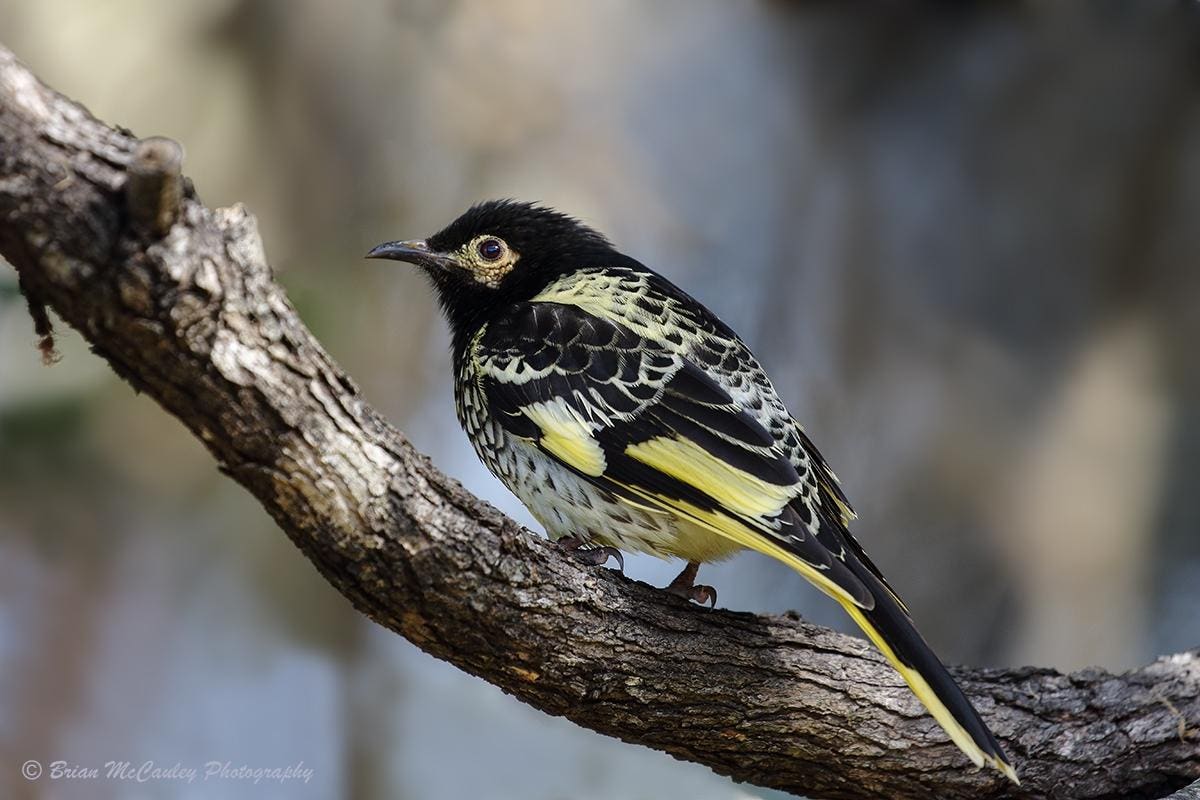Even when genetic diversity appears to be adequate, hidden genetic risks can be present that can compromise a species’ long-term viability.
The critically endangered regent honeyeater (Anthochaera phrygia) has an “adequate” amount of … More
Globally, the biodiversity of plants and animals is in sharp decline and, for many species, it is rapidly approaching dangerous tipping points that pose grave threats to the continued existence of every living being on the planet, according to a report by the World Wildlife Fund (ref). These biodiversity declines are driven by people; through habitat destruction generally due to intense demands from our global food system, often in combination with significant damages from invasive species, disease, overexploitation and climate change.
Conservation of endangered populations and their habitats is one method of helping to preserve endangered species. But many conservation efforts focus on population numbers and visible threats like habitat loss, whereas the genetic health of a species is equally important: but how do population declines affect genetic diversity?
“While we know that genetic diversity is essential for a species to adapt and survive, we know little about how quickly or subtly these genetic changes occur during population declines,” observed the senior author of a recent study, evolutionary biologist Hernán Morales, who is an associate professor at the University of Copenhagen, where he leads the Evolutionary and Conservation Genomics Group. This research group explores the mechanisms underlying the generation, preservation, and loss of biodiversity and develops predictive tools to assess the implications of reduced genomic diversity for the conservation of biodiversity. Professor Morales also holds an ongoing affiliation as a guest researcher at Lund University.
“This knowledge is increasingly important because reports have found that worldwide wildlife populations are declining rapidly,” Professor Morales told me in email.
According to the study’s findings, although the regent honeyeater still has high overall genetic diversity, which allows the population to adapt to changing environments, this is deceptive because of the subtle effects of genetic erosion. Genetic erosion refers to the loss of genetic diversity within a species, which can lead to reduced adaptability and increased vulnerability to threats like disease or climate change. This loss is often accelerated by human activities and can occur at various levels, including the reduction of individual genes, allele frequencies, and entire populations or varieties.
Adult male Regent Honeyeater (Anthochaera phrygia). There are fewer than 250 individuals of this … More
There is one species that can help us answer questions regarding the erosion of genetic diversity: the regent honeyeater.
The regent honeyeater, Anthochaera phrygia, is a songbird that lives exclusively in wooded areas of southeastern Australia, especially along the inland slopes of the Great Dividing Range, where humans are fragmenting and destroying the last of its habitat. This handsome bird feeds on nectar from eucalyptus and mistletoe species, as well as on insects and their honeydew. Like many nectarivorous birds, it also feeds on native and cultivated fruits.
This critically endangered species was already experiencing a dramatic population decline before the 2019-2020 Australian wildfires further reduced its numbers to the point of extinction. Currently, only about 250 of these birds are alive in the wild and thus, it is listed on the IUCN Red List (ref). This bird may yet teach scientists valuable lessons for conserving them, and other endangered species, too, through the presence of specimens in natural history museum collections.
“The regent honeyeater, with its long history of monitoring and the availability of historical museum samples, provided a unique opportunity to address these questions,” Professor Morales told me in email.
In fact, more than half of the specimens used in this study are held in a number of natural history museums around the world.
“This also highlights the incredible value of natural history collections in helping us understand the past and plan for the future,” Professor Morales remarked.
Critically endangered regent honeyeaters (Anthochaera phrygia, left) and another critically … More
To better understand this species’ genetics, Professor Morales and collaborators sequenced the complete genomes of 44 individuals, including 24 historic museum specimens that were collected before 1919 and 20 modern birds sampled between 2011 and 2016. These whole-genome sequence data provided the team with an overview of this species’ genetic changes spanning more than one century.
In this study, Professor Morales and collaborators used a variety of methods to analyze the regent honeyeaters’ DNA, including ecological modeling and forward-in-time simulations to measure genome-wide heterozygosity, inbreeding levels, and population structure. They used two demographic modeling approaches to reconstruct the species’ population history, capturing both long-term trends and recent shifts that show how genetic erosion is developing over time.
Genome comparisons between historic and modern regent honeyeaters revealed a modest but significant loss of genetic diversity. On average, modern individuals showed a 9% reduction in genome-wide heterozygosity compared to historical samples. This comparatively small genetic decline occurred whilst the species experienced a greater than 99% reduction in population size over the same time period, suggesting there is a time lag between demographic collapse and genetic erosion.
Species distribution models were built using historical occurrence data, land use, and climate variables spanning from 1901 to 2015. These models mapped changes in environmental suitability over time and projected future scenarios based on different climate pathways.
The species distribution models revealed a marked decline in environmental suitability across much of the regent honeyeater’s geographic range over the last century. The most significant losses occurred in breeding habitats. Further, Professor Morales and collaborators found that regent honeyeater breeding habitat that remains suitable today is expected to decline rapidly, with most of that loss projected to occur before 2040.
Individual-based genomic simulations added a predictive component. By modelling populations with varying ancestral sizes and bottleneck intensities, Professor Morales and collaborators estimated how genetic diversity and harmful mutations might evolve after a population collapse, revealing how genetic risks can remain hidden long after a population declines.
“Standard diversity measures average the entire genome and may not capture losses in key areas that affect a species’ ability to adapt,” Professor Morales pointed out. “Our study shows that even a modest drop in overall diversity can mask important problems like an increased impact of harmful mutations.”
According to Professor Morales and collaborators’ recent findings, the regent honeyeaters’ genetic erosion will only get worse.
“We also show that genetic diversity loss will continue and accelerate,” Professor Morales continued in email. “This is particularly worrying because our climatic projections show that environmental degradation will worsen and with accelerating genetic diversity loss the species might not have the capacity to respond to this change.”
Do other endangered bird species show similar erosion of genetic diversity?
“Genomic erosion is a growing concern, especially for species that have undergone drastic population declines,” Professor Morales explained in email. “For instance, we recently documented clear signs of genomic erosion on the Orange Bellied Parrot [ref], with genetic diversity loss exceeding 60%, including in critical genes linked to immune responses. Making them susceptible to diseases like the ongoing Psittacine Beak and Feather virus, or the massive looming threat of avian influenza for species worldwide.”
Critically endangered orange-bellied parrot (Neophema chrysogaster) in Melaleuca. (Credit: JJ … More
Genetic erosion has also been identified in other critically endangered birds, such as the whooping crane, the kakapo, the Seychelles paradise flycatcher, and the pink pigeon.
“While not all endangered birds will exhibit the same pattern, many face similar risks,” Professor Morales pointed out in email. “As habitats become more fragmented, even species that seem genetically stable at first can lose critical adaptations over time, which can ultimately threaten their survival. This makes it increasingly important for conservation programs to include long-term genetic monitoring to catch these hidden threats before they lead to irreversible damage.”
What most surprised you about these findings?
“I was struck by the disconnect between the rapid, dramatic decline in population numbers and the relatively modest decline in overall genetic diversity,” Professor Morales replied in email. “It’s counterintuitive that a species with fewer than 250 mature individuals could still appear genetically diverse when measured by traditional methods. But our results show that they might not be. I picture this is a safety net with a few weak spots: on average, it might seem intact, but those holes can eventually compromise the entire structure.”
Regent honeyeater (Anthochaera phrygia). (Credit: David Stowe)
In summary, although high genetic diversity is often viewed as a reassuring sign in conservation practice, this study reveals that this assumption can be entirely misleading. Genetic indicators in populations that have experienced a crash in numbers, such as the regent honeyeater, may actually conceal the early stages of long-term genetic erosion. Without accounting for time-lag effects, risks posed by genetic erosion can remain undetected until it is too late to intervene.
By evaluating both slow-moving historical genomic erosion and rapid ecological deterioration, scientists can create a more realistic timeline for addressing multiple conservation challenges that cannot be addressed in isolation. By integrating both, this research highlights the urgency of early intervention and the need for long-term monitoring strategies that account for both ecological threats and hidden genetic perils.
Source:
Xufen Liu, Ester Milesi, Claudia Fontsere, Hannah L. Owens, Robert Heinsohn, M. Thomas P. Gilbert, Ross Crates, David Nogués-Bravo and Hernán E. Morales (2025). Time-lagged genomic erosion and future environmental risks in a bird on the brink of extinction, Proceedings of the Royal Society B: Biological Sciences | doi:10.1098/rspb.2024.2480
© Copyright by GrrlScientist | hosted by Forbes | LinkTr.ee
Socials: Bluesky | CounterSocial | Gab | LinkedIn | Mastodon Science | Spoutible | SubStack | Threads | Tribel | Tumblr | Twitter








